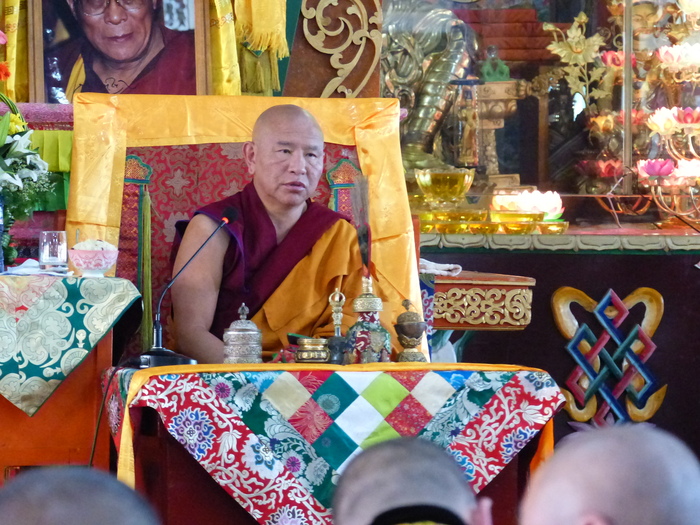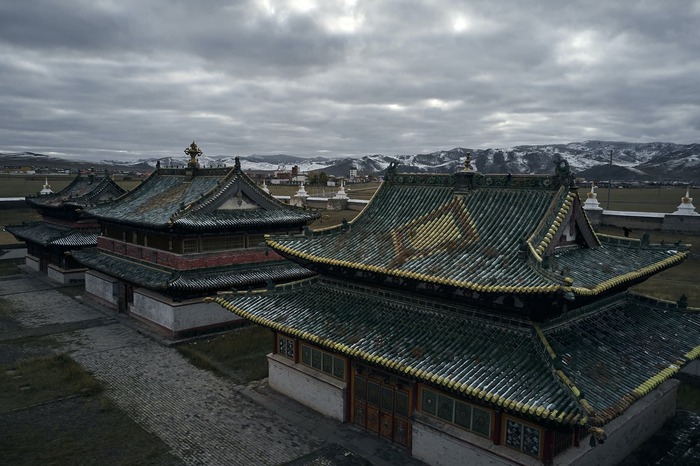
Mongolian Tulkus
By 2022, twenty-two Mongolian tulkus, reincarnations of Mongolian eminent lamas, had been recognized since the democratic change. An additional few have been identified in 2023. They continue their advanced studies at the Tibetan monasteries in India and spend only shorter periods back in Mongolia at their home temples or at their teaching centers if they have any. From time to time, new Mongolian tulkus are still being identified. In the cases where newly identified tulkus have already passed away, the next reincarnations have either already been announced or are being searched for.
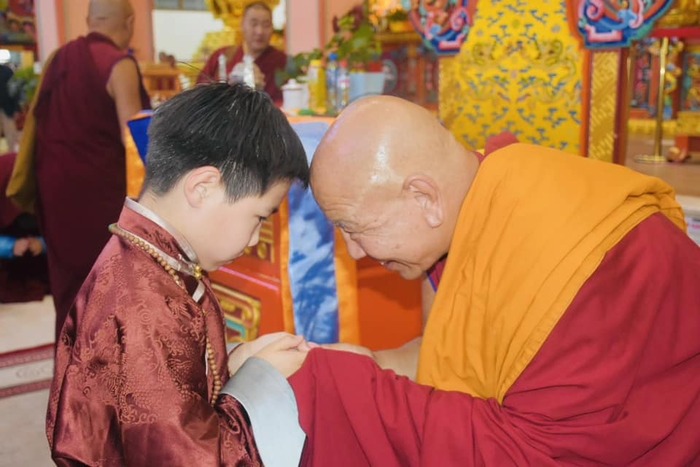
The fact that the number of Mongolian tulkus is growing is important because they are usually among the ones who have the opportunities to pursue their studies for decades in India. As a result, they are able to earn the highest degrees and thus are able to teach on an advanced level either upon their return to Mongolia or even beforehand, between periods of study in India. The two main teachers of the Tenth Bogd have been appointed from among these highly educated Mongolian tulkus, as was traditional.
Tibetan Lamas Playing Important Roles in Mongolia
Jhado Tulku Rinpoche
Kyabje (Khal. jawje, Tib. skyabs-rje, “lord of refuge,” an honorific title for high lamas) Jhado Tulku Rinpoche (Khal. Jado rinbüchi gegeenten, Tib. bya-do sprul-sku rin-po-che), born in 1954, is one of the most highly esteemed Tibetan masters. In the first period after the revival, it was considered extremely important to restore the lineages (Khal. damjlaga, Tib. brgyud), teachings and practices that had once been present in Mongolia but whose transmissions had been broken. D. Choijamts, the Twenty-ninth Khamba Nomun Khan and Head Abbot of Gandantegchenlin Monastery (Tib. dga’-ldan theg-chen gling) (Gandan for short) widely supported these activities. Consequently, many great lamas were widely involved in this endeavor as their main focus, such as Bakula Rinpoche, the late Indian ambassador to Mongolia, whose reincarnation was enthroned in 2017, and many others. Jhado Rinpoche, however, was specially chosen to carry out these activities.
Jhado Rinpoche has had a strong connection with Mongolia from childhood as foretold in a prophecy one of his teachers made concerning his future role in spreading the teachings there. Starting in 1991, he has visited Mongolia many times and continues to visit regularly, often for extended periods, teaching in Ulaanbaatar at the Buddhist College of Gandan and at Betüw Danjai Choinkhorlin (Tib. dpe-thub bstan-rgyas chos-’khor gling) Monastery (Betüw for short). He has given public teachings and empowerments mainly in these two monasteries but also in the countryside in almost all provinces over the years. He has taught in many Western countries as well. He has even learned the Mongolian language and gives shorter teachings in Mongolian, which is extremely rare among Tibetan lamas.
It has already been announced that, in August 2024, Jhado Rinpoche will confer a Kalachakra initiation at Gandan. His Holiness the Dalai Lama himself has appointed him to carry this out. The last such event took place in Mongolia in 1995, when it was the Dalai Lama who conferred the initiation.
On September 30, 2023, Jhado Rinpoche was enthroned as abbot of Betüw Monastery. Betüw was founded by the previous Bakula Rinpoche (1917–2003), with whom Jhado Rinpoche had a close connection. He visited Bakuka Rinpoche’s native Ladakh and his home monastery there several times. With this new position, it seems that Jhado Rinpoche will continue to play an important role in the continuing revival of Buddhism in Mongolia in the coming years.
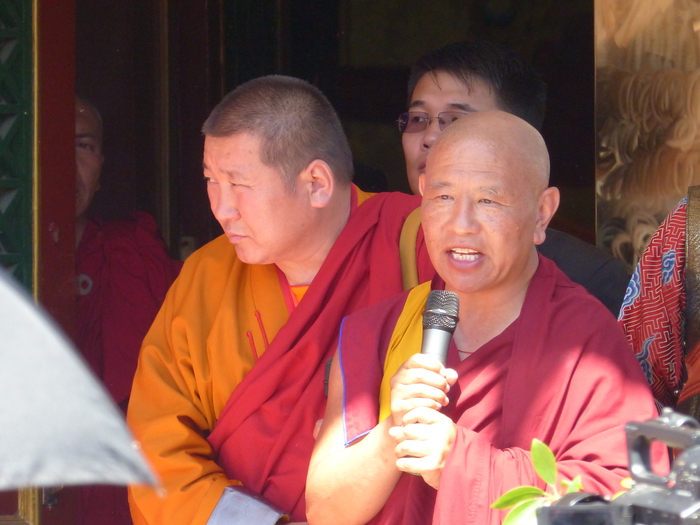
Jhado Rinpoche is the sixth reincarnation of the head lama of Jhado Monastery in Tibet. In 1959, he escaped into exile in India together with other Tibetan high lamas. From 1972 to 1990, he studied at Jey College of Sera Monastery (Khal. Seraje datsan, Tib. se-ra byes grwa-tshang) and was awarded the Geshe Lharampa (Khal. gewsh lkhaaramba) degree in 1991. In 1996, he earned the Ngagrampa (Khal. agramba) degree in tantric studies at Gyuto, the Upper Tantric College (Khal. Jüddod dastan, Tib. rgyud-stod grwa-tshang). From 1992 to 1996, he was a teacher at His Holiness the Dalai Lama’s Namgyal Monastery (Khal. Namjal datsan, Tib. rnam-rgyal) and served as its abbot from 1997 to 2004. Thus, he bears the title Khensur (Khal. khansür, Tib. mkhan-zur), “abbot emeritus,” of this monastery. After that, from 2013 to 2017, he served as abbot of Gyuto Upper Tantric College.
Ajaa Gegeen
Gandan, its monastic schools, and several of the smaller temples continue to have Tibetan resident lamas, some changing periodically and some visiting annually. Here, we make special mention of only one more tulku – one who is not associated with any of the monasteries in Mongolia, but who is known and respected mainly for his charitable activities there.
The Eighth Ajaa Gegeen (Arjia Rinpoche, Agya Hotogtu, Tib. a-kyA ho-thog-thu), Lobsang Tubten Jigme Gyatso (Khal. Luwsan tüwden jigme jamtso, Tib. blo-bzang thub-bstan ’jigs-med rgya-mtsho), the only high Tibetan tulku of Mongolian origin, visits Mongolia almost every year. There, he heads the Center for Compassion and Wisdom (Khal. Enerel nigüüsel oyuun bilgiin töw) and runs different charitable projects to enhance the well-being of Mongolians and to preserve Mongolian culture. These projects include a Children’s Cancer Care Treatment Center, opened in 2014, a Senior’s Activity Center and, from 2019, a scholarship program for young people from poor families for their higher education, and so on.
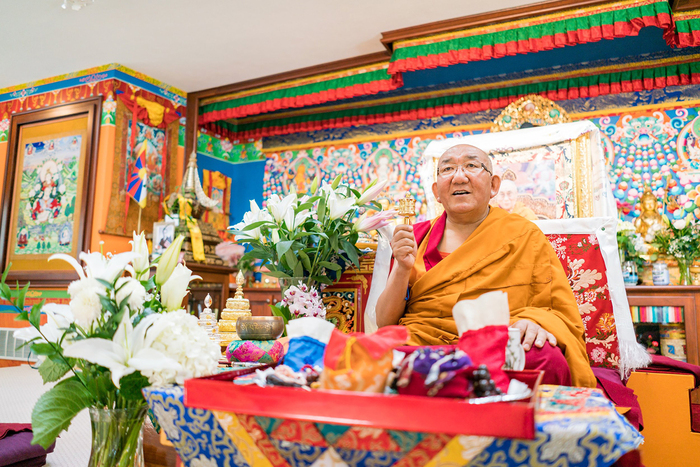
Born in 1950 to Mongolian nomadic parents, Ajaa Gegeen was recognized at age two by the Tenth Panchen Lama as the reincarnation of Tsongkhapa’s father and of the throne holder and abbot of Kumbum Monastery (Khal. gümbüm, Tib. sku-’bum). As such, he became the abbot of Kumbum. Among his early main teachers were the Fourteenth Dalai Lama and the Tenth Panchen Lama, but under Communist Chinese rule, he was forced to attend Chinese school and was imprisoned for many years in labor camps. He was only secretly able to continue his study and practice with his tutors. Thus, in periods when circumstances allowed, he studied at the Panchen Lama’s Tashilhunpo (Khal. Dashlkhümb, Tib. bka-shis lhun-po) Monastery and occasionally stayed in Lhasa (Khal. lkhas, Tib. Lha-sa) as well. In 1979, he was reinstated as abbot of Kumbum, where he managed to reestablish monastic studies but only to the extent that circumstances allowed. It was only in 1998 that, with the growing political strain around the question of the Panchen Lama’s reincarnation, he was able to leave China and go to into exile.
Living now in the USA, he heads two temples, the Tibetan Center for Compassion and Wisdom (TCCW) in Mill Valley, California, and the Tibetan Mongolian Buddhist Cultural Center (TMBCC) in Bloomington, Indiana. A handful of lamas from Dashchoilin Monastery studied for several years at Kumbum Monastery under his sponsorship in the 1990’s and thus they have been his main helpers in Mongolia.
Monks and Monasteries in Opposition to the Head Abbot of Mongolian Buddhists
In recent years, there has been open criticism from a handful of monks against the recently retired Gandan abbot, D. Choijamts, and his role as the leader of Mongolian Buddhists. This movement is led by Z. Sanjdorj, the head of a small Ulaanbaatar temple, Ikh Khüree Monastery, as well as of Shar Ordon Temple (“Yellow Palace” temple). In fact, he heads several temples that have changed names in the last decades and that are built next to each other on the main road leading to Gandan Monastery.
He has based his opposition on the argument that D. Choijamts had been educated at Gandan University during the communist period, and thus his appointment and the governing body led by him was also communist and therefore not legitimate.
The supporters of Z. Sanjdorj are from the monasteries that belong to the cult of Shügden (Khal. Shugden, Tib. shugs-ldan), the controversial sectarian protector that the Dalai Lama warns against as divisive and dangerous and advises his students not to worship. The followers of this cult are often actively hostile to the Dalai Lama. These Mongolian monasteries supporting this cult are said to be backed by Chinese Buddhists and the “Chinese Panchen Lama.” This support is easily witnessed by the rich furnishings in these monasteries and the golden ritual implements used for its worship, making a stark contrast with all the other Mongolian monasteries.
Among the main monasteries belonging to the Shügden cult is Sain Nomun Monastery (“Good Dharma Teaching” Monastery), located about forty kilometers from Ulaanbaatar in Nalaikh. Its head, S. Nergüi, also actively takes part in these criticisms of D. Choijamts and was present when they even asked for an audience in 2021 and handed over a petition to D. Choijamts demanding his resignation. The other lama present was D. Mendbayar, head of Narkhajid Women’s Center (Narkhajid süm, Tib. Na-ro mkha’-spyod). Other monasteries following this cult are Tögsbayasgalant Women’s Center in Ulaanbaatar, Delgeriin Choir Monastery in Dundgow’ province, and Amarbaysgalant Monastery in Selenge province.
The veneration of Shügden in all these monasteries is partly due to their connection with the late Gurudeva Rinpoche (Khal. Gürüdewa Rinbüchi) (1908–2009), a monk from Inner Mongolia who contributed greatly to the revival of Mongolian Buddhism but spread this practice. He had emigrated to Mongolia from India due to the controversies there surrounding the cult. These monasteries also have close connections with foreign monasteries and organizations following this cult. This protector had even been venerated at Gandan in its Güngaachoilin Monastic College (Tib. kun-dga’ chos-gling grwa-tshang) and Kālacakra Monastic College (Dechingalaw, Tib. bde-chen bskal-pa or Düinkhor datsan, Tib. dus-’khor grwa-tshang) until the 2010’s when this practice was ended.
The same opposing monks had negative comments and open criticism even after the installation of the Tenth Bogd and often hold press conferences to express their opinions. In the month that has passed since the enthronement of the new Gandan head abbot in November 2023, there has been no news about their opinion concerning his leadership. All in all, however, this is not a significant movement and the general popular opinion of them is very negative due to their Chinese support.
Laypeople’s Growing Possibilities for Study and Practice
Lay patrons (Khal. öglögiin ezen or jandag, Tib. sbyin-bdag) played a large part in financing the restoration and rebuilding of temples in Mongolia at the time of the revival of Buddhism. They also have been supporting the operation of assemblies and the education of lamas, and still do so today. Supporting the monastic community (the Sangha) is a way of building up merit (Khal. buyan khuurakh, Tib. bsod-nams sdud-pa, dge-ba sdud-pa). This includes making donations (Khal. öglög, Tib. sbyin-pa, Skt. dāna), “rejoicing” at good deeds (Khal. dagan bayasakh, Tib. rjes-su yi-rang-ba, Skt. anumodana), sponsoring the performance of annual, monthly or weekly rituals, and commissioning the performance of specific rituals and the recitation of specific texts (Khal. nom unshuulakh, nom ailtgakh) for the fulfillment of special aims.
In addition to building up merit and supporting the monasteries in the above ways, some laypeople have also wanted to study the teachings in order to understand Buddhism better. Opportunities for this were initially made available, and continue to be offered, at Buddhist centers founded by foreign organizations such as FPMT Mongolia (the Foundation for the Preservation of the Mahayana Tradition) (Khal. Ikh Khölgönii Ulamjlalyg Khadgalakh Töw) and the Kunchab Jampaling Center (Khal. Günchaw Jambaalin Töw) of Panchen Ötrul Rinpoche (Khal. Banchin Oibürül rinbüchi), a Lharampa Geshe heading a center in Ireland and visiting annually. Since then, Buddhist centers founded by Mongolians themselves have also concentrated on laypeople’s Buddhist education.
Now, in 2023, Mongolian laypeople have many possibilities for studying Buddhism, either outside the monasteries or in them. In addition to their residing Tibetan masters or their Mongolian teachers offering occasional lessons for laypeople, several of the largest monasteries have also started courses for them. There are also several Buddhist associations and centers, mostly led by an individual Tibetan or Mongolian lamas, offering the same. One such association, operating since the late 1990’s, is Tarema Association, led by Geshe Sonam Dorje (Sonomdorj, Tib. bsod-rnams rdo-rje), a Tibetan lama from Ladakh. These centers conduct rituals and offer teachings on special days of the month in accord with the traditional ceremonial calendar. They also offer occasional empowerments and hold other events such as annual rituals at owoos (Tib. la-rtse / lab-rtse / la-btsas), stone heaps for the veneration of local spirits.
For Mongolian laypeople participating in such rituals in these centers and even at certain events and lectures at monasteries, Tibetan texts of the prayers that are chanted are distributed in Cyrillic transcription. In this way, they can join in the chanting without knowing Tibetan. This method is sometimes also used in Western Buddhist assemblies as well. Many regular participants memorize the texts and are able to chant them with the traditional melodies that are used. This is complemented with detailed explanations of the texts provided both during lessons and also in publications containing translations and added explanations. Many recorded lectures are also available online. This is a big change for Mongolian lay Buddhists, from when they previously had only blind faith in the teachings but no understanding to now when they have a wide range of possibilities for studying them.

Occasional programs, teachings and short courses held in monasteries, Buddhist centers and organizations designed especially for laypeople include instruction on different meditation methods, various Buddhist texts and practices, Tibetan language, the classical Mongolian script, other Mongolian scripts, calligraphy and even the making of balin (torma, Tib. gtor-ma, ritual dough cake offerings). The traditional teachings for the lamas are also available for laypeople, including empowerments (Khal. wang, Tib. dbang), oral transmissions (Khal. lün, Tib. lung), and occasional teachings by Mongolian or Tibetan lamas. Most of these are held at Gandan or one of its monastic colleges, as well as at Dashchoilin, Betüw, or one of the larger countryside monasteries. Attending such teachings is called in Mongolian nomond suukh – literally, to sit at a teaching – and Mongolian lay practitioners often take advantage of these possibilities for their spiritual advancement. Longer or more advanced courses requiring more commitment are also available in monasteries and Buddhist centers for laypeople.
Degree Programs and Courses Offered in Monasteries for Lamas and Laypeople
As of 2013 there are BA degree programs offered in two monasteries: the Zanabazar Buddhist College of Gandan (Khal. Öndör gegeen Zanabazaryn neremjit (mongolyn) Burkhany Shashny Deed Surguul’) and the College of Züün Khüree Dashchoilin (Khal. Züün Khüree Kollej). Both were originally only for the lamas there, but the BA programs of both monastic colleges have been made open to laypeople as well.
Zanabazar Buddhist College
Laypeople have been admitted to the Zanabazar Buddhist College of Gandan since 1995. The college was opened in 1970, with a compulsory syllabus set at the time by the communist regime. It included communist doctrine and some modern subjects along with limited topics from the traditional monastic education. At the 2023 graduation, degrees in three majors were conferred – philosophy/Buddhist philosophy, linguistics/Tibetan and Sanskrit languages, and religious studies/rituals. The curriculum has now been expanded to include five majors. In addition to the above three, students can also major either in language & literature/scripts & Tibetan language or in fine arts & painting/traditional sculpture. This last topic was originally taught at a separate institution within Gandan, called the “Mongolian Institute of Buddhist Art” (Khal. Mongoliin Burkhany Shashny Urlakhuin Ukhaany Deed Surguul’). It was founded in 1993 and led by G. Pürewbat Lama until it was merged with Zanabazar Buddhist College.
Starting in 2014, Gandan has also offered a two-years’ evening course (Khal. oroin deed kurs) to enable laypeople to attend after working hours. Each year, fifty to sixty persons have been studying in these courses in two parallel groups. The course was initiated by the Association of Mongolian Believers (Khal. Mongol Süsegtnii Kholboo) and is run by Gandan University and this organization. The two years’ course includes subjects such as Buddhist philosophy and Tibetan language and writing. All are taught by teachers of the Gandan University. The ninth class was graduated in 2023.
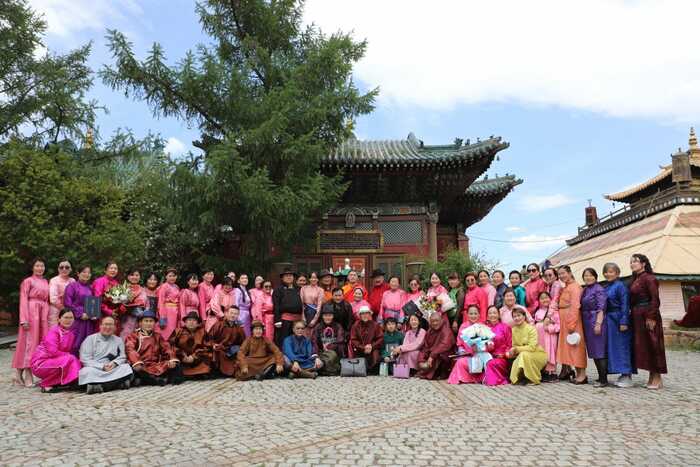
The College of Züün Khüree
The College of Züün Khüree Dashchoilin monastery was opened in 1998 and offers degrees in two majors. The first is philosophy/Buddhist philosophy. It is supplemented by classes in classical and spoken Tibetan, Sanskrit and Mongolian, and in traditional Mongolian beliefs. The classical Mongolian script (Khal. mongol bichig), the Soyombo script created by Öndör Gegeen Zanabazar, and the vertical square script (Khal. bosoo dörwöljin), or Phagpa script (Khal. pagwa, Tib. ’phags-pa), created by the Tibetan Phagpa Lama are also taught.
The second major is linguistics/Oriental comparative linguistics/scripts. This major was started in 2002 by Ts. Mönkh-Erdene, a Dashchoilin monk, a calligrapher trained in many scripts, a teacher at the college and, at that time, the head of education at the college. The training was modelled after the so-called “School of the Nine Kinds (of Writings)” (Khal. Yesön züilin surguul’) of the old Züün Khüree, the eastern monastic district. Similar to its predecessor, this major is aimed at preparing students for studying the manuscripts and other sources written in many different scripts. Thus, the students are taught many Indian, Tibetan and Mongolian scripts, which include not only the classical, Soyombo, and square Mongolian scripts, but also the Oirat script (Khal. tod bichig, “clear script”) created by the Oirat Zaya Pandita in 1648.
The monastery runs evening courses and other shorter courses as well, such as several levels of Tibetan language courses and classical Mongolian calligraphy. These are in addition to the teachings given at annual festival days or on other occasions, which other, smaller monasteries offer as well.
Courses Offered in Buddhist Centers for Laypeople
Several Buddhist centers offer two to three-year-long certificate courses for laypeople. In most of them, Tibetan language and translation is taught as part of the curriculum or is taught separately. Some such courses were continued online during the covid period and later have remained available for those living far away or abroad.
Jebtsundampa Khutagt Center
Jebtsundampa Khutagt Center (Khal. Jawzandamba Khutagt Töw), founded in 2004, offers a two-years’ course for laypeople. The first course was started in 2016, and the eighth class was graduated in 2023. The course is held in the evenings three times a week. The subjects include basic Buddhist teachings, Buddhist philosophy, Tibetan language and writing, and Tibetan translation. This latter entails translating about ten basic Tibetan Buddhist prayers and texts as well as memorizing and reciting them by heart. Other subjects include Shantideva’s Engaging in Bodhisattva Behavior (Tib. spyod-’jug, Skt. Bodhicāryāvatara), Buddhist philosophy and debate, and also meditation – interestingly, based on the mindfulness meditation (Khal. sanamsaryn byasalgal) method of Oxford University.
The main teacher is Geshe D. Nyamsambuu, who was educated for ten years at Drepung Monastery in India and then studied in Great Britain, where he graduated in Religious Studies. Geshe Luwsangenden and Kachu Nanzaddorj also teach the latest course. Currently, in 2023, this center has two Tibetan lamas from Jey College of Sera Monastery in India, Geshe Lharampa Tüwdennamdag and Geshe Lharampa Tüwdenchoisan, who often teach on the annual and monthly festival days. The center is also widely involved in charity.
Chukhagt Erdene Center
Chukhagt Erdene Center (Khal. Chukhagt Erdene Töw), or Chukhagt Erdene Cultural Center (Khal. Chukhagt Erdene Soyol Gegeerliin Töw) – its name Chukhagt translates as “supreme jewel” – is a relatively newly established, but very active Buddhist center. It was founded in 2017 and was officially registered by the state in 2020. It was established and is run by B. Darambazar, a monk from Dashchoilin who also works for the Kalachakra Culture Center (Khal. Tsogt Tsagiin Khürden Soyolyn Töw), which is a translation center. All courses are taught by B. Darambazar himself, including a three-year lamrim course started in 2020, with the first class graduated in 2023. This was an extensive course with 150 videos, 800 pages of written material and a written examination, based on which diplomas were issued. In addition, B. Darambazar conducts extensive research and has published several books, among them translations.
In 2023, a new course was advertised on Buddhist philosophy (Khal. choiryn surgalt) and on debate for people already able to read Tibetan. Other shorter courses are also offered, such as 45-day meditation courses and triweekly Tibetan language. Tibetan language courses such as these taught in Mongolia always include memorizing and reciting the texts, starting with shorter basic prayers and daily recitation materials. Apart from the courses, the center, similar to all others, holds regular practices and conducts rituals on special Buddhist days of the month.
Buman Khand Kholboo
Buman Khand Kholboo, the Association of the Hundred Thousand Dakinis, is another center for the education of laypeople, especially women. Dakinis (Khal. khand(ma), Tib. mkha’-’gro-ma, Skt. ḍākinī) are realized beings in female form who help practitioners to attain enlightenment. The center is run by Günzee Chimed, who had studied with the Ninth Bogd in Dharamsala and had been his chant master. She is a practitioner of chö (Khal. zod, Tib. gcod or Khal. lüijin, Tib. lus-sbyin, offering the body), which she also learned from the Ninth Bogd. She is also a famous singer and has made several recordings of Buddhist chants. The courses here include ones on Tara practices (Khal. Dar’ ekh, Tib. sgrol-ma, Skt. Tārā) and on chö, as well as on Tibetan language at different levels. Ceremonies are also held at the festival days, as usual.
There are also a few possibilities for Buddhist study in the countryside, or people can join some courses online that are held in the capital. All in all, the possibilities for laypeople to study Buddhist theory and practice or the Tibetan ritual language are manifold in contemporary Mongolia. It is really astonishing to see the number of people attending these courses, sitting the examinations and even defending their degrees in the various fields.
Buddhist Studies at the Research Centers of Monasteries, Universities and Independent Research Centers
In modern times, monasteries are not only places of worship and rituals, but also centers where research on the Buddhist teachings and the history of Buddhism is conducted, meeting the standards of modern academia. Gandan and Dashchoilin and their institutions regularly hold conferences and workshops on different topics related to Buddhist studies. Other monasteries occasionally hold these as well. These conferences generally focus on the activities and works of different tulkus (khutagts, khuwilgaans or gegeens) or great masters of Mongolian Buddhism, on the history of a given Mongolian monastery, history of the monasteries of a given Mongolian area, or on topics such as the lamrim teachings or the chö practices and their presence in Mongolia. Monasteries, sometimes from the countryside, of the given master studied and smaller Ulaanbaatar monasteries sometimes work together to organize these conferences and events.
The Department of Philosophy and Religious Studies at the National University of Mongolia (NUM) (Khal. Filosofi, shashin suudlalyn tenkhim, Mongol Ulsyn Ikh Surguul’ [MUIS]), for example, also sponsors such conferences. Buddhism has been studied there as part of the curriculum since 1994. The teachers in this department and in other related departments such as history or Mongolian language also contribute widely to Buddhist studies. In 2023, a circle for Tibetan language and writing (Khal. Töwöd khel bichgiin duguilan) was established at the department of Mongolian language and linguistics in cooperation with the monasteries and their colleges. This pattern of university research centers working closely with monasteries was established in Mongolia with Gandan during the communist times.
One of the main research institutions affiliated with monasteries is the Research Institute for Buddhism and Culture (Khal. Burkhany Shashin Soyol sudlalyn Khüreelen) of Dashchoilin Monastery. It was led by Ts. Mönk-Erdene until his death in 2021. G. Myagmarsüren has followed in the position. The institute has published numerous works, mainly translations of Tibetan texts or of collected works of different Mongolian lamas written in Tibetan.
The Kalachakra Culture Center (Khal. Tsogt tsagiin khürden soyolyn töw), founded in 2008 and led by G. Buyandelger, formerly a lama of Dashchoilin, has undertaken translating and publishing in modern Mongolian the entire Kangyur (Khal. ganjuur, Tib. bka’-’gyur, the translated words of the Buddha) and Tengyur (Khal. danjuur, Tib. bstan-’gyur, the translated Indian treatises to the Buddha’s teachings) and making them available to all interested persons. By the end of 2023, 126 volumes had been published out of the approximately 270 volumes – 30 from the Kangyur and 96 from the Tengyur. The texts are translated from Tibetan but in consultation with the classical Mongolian versions. The center has produced numerous other publications as well. Many of the translators working here joined after having finished their studies and having trained in Buddhism and these classical languages at Dashchoilin’s College.
In addition, there are a few Mongolian research institutions not affiliated with any of the monasteries, but where Mongolian Buddhism and its history and main figures are studied as parts of programs in history. All in all, in 2023, slightly more than thirty years after the revival of Buddhism was begun, there is a significant number of institutions, either affiliated with monasteries or independent of them, for the study of Buddhism and its Mongolian forms. These not only publish widely but also organize many conferences and other events making their research results available.
